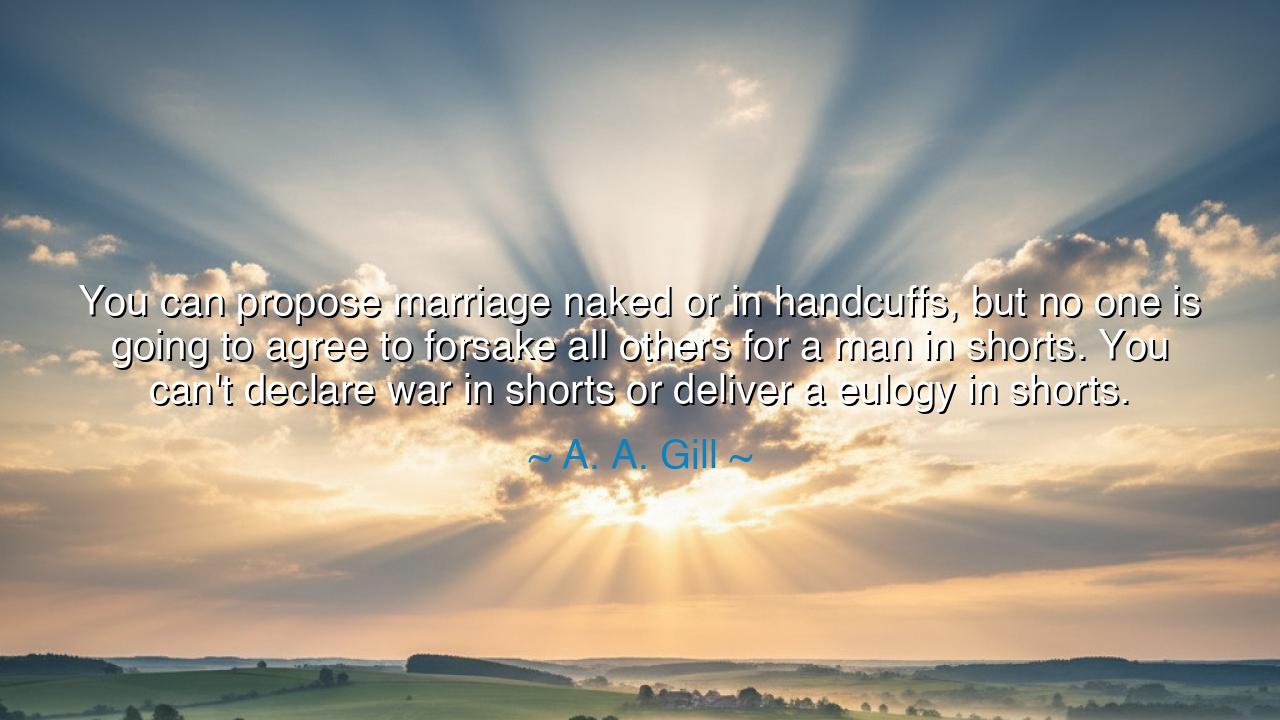
You can propose marriage naked or in handcuffs, but no one is
You can propose marriage naked or in handcuffs, but no one is going to agree to forsake all others for a man in shorts. You can't declare war in shorts or deliver a eulogy in shorts.






In the wry yet profound words of A. A. Gill, master of wit and observer of human nature, we hear more than a jest: “You can propose marriage naked or in handcuffs, but no one is going to agree to forsake all others for a man in shorts. You can’t declare war in shorts or deliver a eulogy in shorts.” Beneath this playful sentence lies a meditation on the sacred power of dignity, ritual, and presentation. For Gill, the subject is not truly about clothing—it is about the symbols through which human beings express reverence, seriousness, and respect. He reminds us that there are moments in life when the soul must rise above casualness, when the external form becomes the vessel for the inner weight of meaning.
To grasp the meaning of this quote, we must look beyond the humor and recognize its wisdom. The shorts, in Gill’s imagination, are not mere garments; they are symbols of informality, of an age that has forgotten the gravity of its own ceremonies. His words speak of the loss of decorum in modern times—the erosion of those customs and appearances that once helped us express honor, commitment, and awe. In every great act of life—love, war, mourning—there exists a sense of the sacred. To dress for such occasions is not vanity; it is participation in their solemnity. Gill’s lament is not about fashion, but about formality as reverence, about remembering that how we appear is an expression of how deeply we feel.
The origin of this sentiment lies in the ancient understanding that clothing is not merely to protect the body, but to honor the moment. In every culture, garments have marked the transitions of life: the robe of the priest, the armor of the soldier, the wedding gown of the bride, the mourning black of the bereaved. These were never trivial things—they were visible symbols of invisible truths. The Greeks clothed their heroes in ceremonial armor before battle, not simply for protection but to acknowledge that war was an act of destiny. The Romans donned togas when addressing the Senate, recognizing that the toga was not cloth but authority made visible. Gill, in his modern way, is calling us back to that understanding: that in the most sacred acts, appearance is an expression of meaning, not a denial of it.
Consider, for example, Winston Churchill, standing before the British Parliament in 1940 as the shadow of war fell upon Europe. He wore not grandeur but gravity—his dark suit and steady demeanor reflected the seriousness of the hour. Could such a moment have been carried by a man in shorts? Of course not. The solemnity of the attire matched the weight of the words, the fabric mirroring the fabric of the nation’s endurance. Or think of the soldier’s uniform—how its crispness embodies duty and unity. Even the simple act of dressing for the task ahead becomes a vow, a preparation of the soul. In this, Gill’s humor hides truth: that the garments of formality are the garments of respect.
Yet there is more to his message. In an age that celebrates ease and informality, we risk forgetting that the truest expressions of humanity demand ritual seriousness. When one kneels to propose marriage, it is not enough to mean love; one must show it, through gesture, voice, and yes—even attire. To declare war or to deliver a eulogy are acts bound by history and emotion—they demand that we bring our best selves to the moment. Shorts, in this sense, represent a carelessness of spirit—a refusal to acknowledge the weight of the occasion. Gill warns that when we abandon these small acts of reverence, we begin to lose the larger sense of meaning that they symbolize.
In this way, the quote becomes a meditation on the nature of respect—for others, for tradition, and for life’s solemn passages. To dress properly is to say, “This moment matters.” It is to affirm that love deserves ceremony, that grief deserves gravity, that leadership deserves poise. The ancients knew this well: when they entered temples, they cleansed themselves; when they stood before their dead, they adorned themselves in mourning cloth. These were not superficial acts, but acknowledgments that the sacred requires both inner and outer preparation.
The lesson that Gill leaves us with, wrapped in laughter, is profound: treat the great moments of life with the reverence they deserve. Do not confuse informality with authenticity; do not mistake casualness for sincerity. There is a time for comfort and a time for ceremony, a time for laughter and a time for solemnity. To approach love, loss, or duty without the dignity they command is to rob them of their sacredness.
Therefore, let these words be remembered: You can propose marriage naked or in handcuffs, but not in shorts. For nakedness is honesty, and even chains can symbolize sacrifice—but shorts, in their careless comfort, symbolize nothing at all. Let us live, then, as those who understand that even in a world that rushes toward ease, formality still has its place. To honor life’s great moments through respect, preparation, and presence is to say to the universe: This matters. This is sacred. And in that acknowledgment, we find the essence of civilization itself—the union of meaning and form, the marriage of soul and ceremony.






AAdministratorAdministrator
Welcome, honored guests. Please leave a comment, we will respond soon